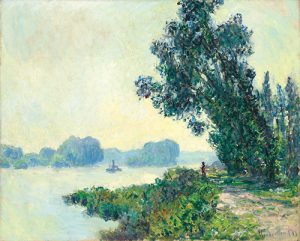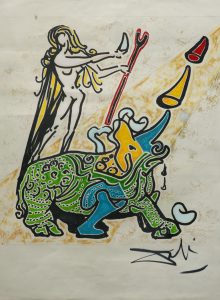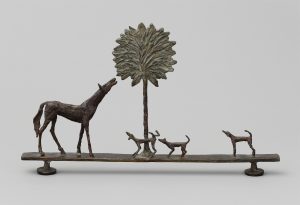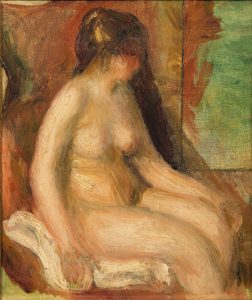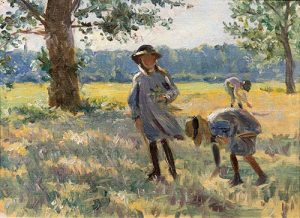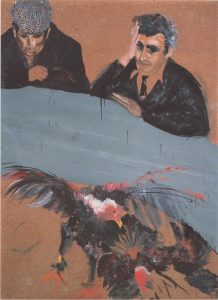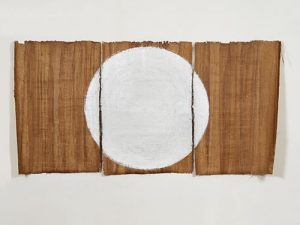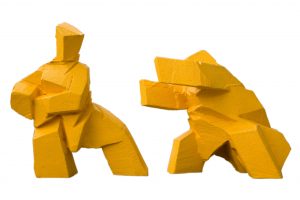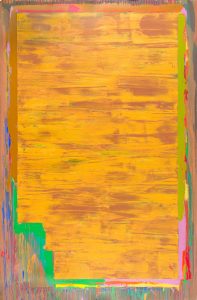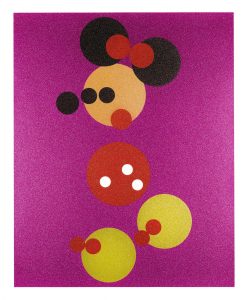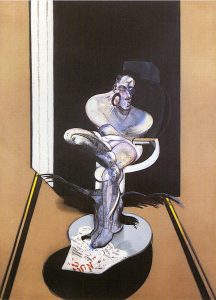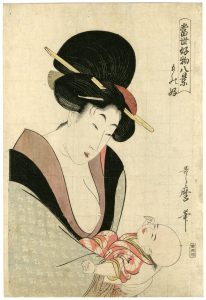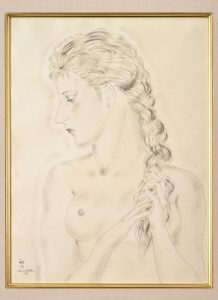Impressionist, Modern & Contemporary Art to be showcased at Fine Art Asia 2018
29 September – 2 October 2018, Hong Kong Convention and Exhibition Centre
Fine Art Asia 2018 offers a unique opportunity to view and acquire masterpieces of Impressionist and modern art. Fine Art Asia has led the way in recognising the growing interest among Asian collectors in Western as well as Chinese art, and this is reflected in the outstanding works of art on display.
Gladwell & Patterson, London, which has exhibited at Fine Art Asia for many years, will once again display an impressive selection of Impressionist and modern paintings. A major highlight this year will be Le Chemin de Halage à Granval by Claude Monet (1840-1926). Painted in 1883, Le Chemin de Halage à Granval is one of the earliest works that Claude Monet painted after moving to his now legendary home at Giverny, where he lived for the rest of his life. Monet was delighted with the area and set about exploring and painting the neighbouring countryside and the River Seine, which was less than one kilometre from the house. Le Chemin de Halage à Granval is the only picture that Monet made showing this view on the banks of the Seine, facing upstream from the towpath towards the islands of Port-Villez.
An incredible atmosphere of stillness and timelessness permeates the painting, deliberately punctuated by the presence of a figure walking along the towpath and a boat in the background, reinforcing the idea that this picture shows a fleeting moment while also leading the eye into the composition and lending a sense of scale to this sweeping vista.
Monet was clearly pleased with the works that he completed in his new environs. It appears that, as was the case with the works he had painted at Etretat at the beginning of 1883, he put the finishing touches to these pictures in his studio, having begun them en plein air.
Le Chemin de Halage à Granval has a distinguished history: it was purchased by Galeries Durand-Ruel in Paris in December 1883, and later collected by Jean d’Alayer and his wife Marie-Louise (née Durand-Ruel), who had amassed a formidable range of Monet’s works.
Another highlight of the exhibition is a masterpiece by Salvador Dali entitled La Vierge et le Rhinocéros. This painting was created in preparation for a stained glass project which was installed at the Teatro-Museo Dalí, Figueras, and was later used in the lithographic series Les Vitraux (c.1974) and La Jungle Humaine (c.1976). Rendered with a graphic simplicity and bold colours, fittingly for its transformation into coloured glass, the work also draws together two familiar subjects which appear repeatedly within Dalí’s pictorial landscape – the rhinoceros and the virgin. The rhinoceros, and in particular its horn, held a specific emotional and symbolic significance for Dalí. Rather than it being a symbol of male virility, the horn is conceptualised as a symbol of chastity through its association with that of the unicorn. Indeed, moving beyond associations with the mythical, the rhinoceros was believed by Dalí to be a cosmic animal, belonging to the heavenly domain in much the same way as the virgin. These seemingly contradictory figures consequently serve to convey one of Dalí’s central beliefs, that through chastity and impotence, creative spirituality can be achieved.
Galerie Dumonteil, Paris/Shanghai/New York, founded in 1982, has been located for more than 30 years in the heart of the Left Bank, Paris. The gallery is renowned for exhibiting the great sculptors, painters and eminent photographers of the 20th and 21st century, whose work is devoted to animal themes and nature. This year Galerie Dumonteil will participate in Fine Art Asia for the 9th time.
Among the highlights of the exhibition will be an important bronze sculpture La Promenade des Amis by the Swiss sculptor Diego Giacometti (1902-1985), the younger brother of Alberto Giacometti. They worked closely together and shared the same sculpture studio in Paris until the ends of their lives. Diego began using animal imagery in his work around 1935, perhaps influenced by growing up on the family farm in Switzerland. He tirelessly modelled in clay to portray the essence of each animal, later combining the separate elements in bronze to create often humorous and always engaging tableaux of implied or imagined narrative. Diego’s creativity, while in the same stylistic movement as that of his brother, is completely independent. The humour that emerges from the poses adopted by the small animals, rendered sympathetic under the fingers of the sculptor, in no way neglected the elegance of the forms. The Friends Promenade – three dogs of uncertain pedigree that live their lives without concerning themselves with what man thinks – is a quintessential example of his work.
Another centerpiece is Deux Elephants se Suivant by the Italian sculptor Rembrandt Bugatti (1884-1916), one of the most talented sculptors of the 20th century who was known primarily for his bronze sculptures of wildlife subjects. He was born in Milan, into an artistic family. In 1902 the family moved to Paris, where they lived in a community of artisans. Rembrandt Bugatti’s love of nature led to him spending a great deal of time in the wildlife sanctuary near the Jardin des Plantes in Paris or at the Antwerp Zoo where he studied the features and movement of exotic animals. His sculptures of animals such as elephants, panthers and lions became his most valuable and popular works. He loved animals and spent days observing — and often interacting with — his subjects. Rembrandt Bugatti was one of the finest ever sculptors of animal figures. In a career cut short by his tragic suicide at the age of 31, he created an impressive body of work. His art combined enormous technical skill, formal beauty and intensity of expression.
Exhibiting for the first time at Fine Art Asia, Haynes Fine Art, London and Cotswolds, established in 1971, is a family run business which has built up a strong reputation for presenting major pieces by British artists, such as John Atkinson Grimshaw, Arthur John Elsley, Joseph Farquharson, Heywood Hardy and David Shepherd; as well as European artists such as Renoir, Bernard Buffet and Dali.
Highlights at Fine Art Asia 2018 include Femme Nue Assise (Seated Nude) by Pierre-Auguste Renoir (1841-1919). This work will be included in the forthcoming Pierre-Auguste Renoir Digital Catalogue Raisonné, currently being prepared under the sponsorship of the Wildenstein Plattner Institute, Inc. Other highlights are Nature Morte à la Cafetière Bleue (Still Life with Blue Coffee Pot) by French artist Bernard Buffet (1928-1999); Gathering Daisies by Dorothea Sharp (1874-1955), a British artist best known for her landscapes and naturalistic studies of children at play; La Cueillette des Fleurs (Picking Flowers) by French post-impressionist painter Henri Lebasque (1865-1937); and Danseuse à la Barre (Dancer at the Barre) by Edgar Degas (1834-1917).
For the first time at Fine Art Asia 2018, Fabio Rossi in partnership with Giovanni Martino will present Post-War and Contemporary Italian art in response to the growing demand for Western art in Asia. Highlights of Rossi Martino’s exhibition include Combattimento di galli, an exceptional painting on linoleum from 1991 by the Italian postmodern artist Aldo Mondino (1938-2005). Mondino was fond of using unusual materials, linking the concepts of Arte Povera with emotions. He was deeply fascinated by his travels and painted intimate portraits of people he saw along the way, such as Moros y Cristianos, a festival celebrated in cities and towns across Spain commemorating the battles between the Moors and Christians.
Also exhibited is a work on papyrus by the Italian-born, New York-based artist Massimo Antonaci (b. 1958) Widely recognized for his daring use of materials, Antonaci’s works in tar and glass have received international acclaim. Drawing on his vast research in history and religion, Antonaci’s work is replete with symbolism and mystery.
A monumental totem by Italian contemporary polyhedric artist Giorgio Vigna (b. 1955) is another highlight. Composed of bracelets made of a variety of metals, the totem emerges as a stalagmite marked by mysterious underground cavities. Vigna employs a kind of alchemy to invite the viewer to rediscover the reality of nature. The exhibition also includes lifelike ceramic sculptures by the artist duo, Bertozzi & Casoni (b. 1957, 1961). Their sculptures – symbolic, mocking and pervaded by sense of attraction for all that is short-lived, perishable and decaying – have become internationally recognised metaphors of the human condition.
Participating in Fine Art Asia for the first time, iPreciation, Singapore, established in 1999, is a fine art company that showcases the best of modern and contemporary Asian Art. At Fine Art Asia 2018, iPreciation will present a major life-size work from the Taichi Series by Ju Ming (b. 1938), renowned as Asia’s most pre-eminent living sculptor, having forged a signature style that is recognised throughout the art world. He is best known for his iconic Taichi Series, powerful and often monumental figures in both wood and bronze, which were inspired by the ancient martial art of tai chi chuan and which celebrate both the physical and spiritual aspects of this age-old Asian practice. Born in a poor family in rural Taiwan in 1938, he was apprenticed to a carver of wooden images for Buddhist temples but soon became a master craftsman, studying with the famous Taiwanese sculptor Yuyu Yang (1926 – 1997), considered the first “modern” Chinese sculptor.
Like Yuyu Yang, Ju Ming moved away from the realism of traditional figural sculpture, opting instead to carve essential, semi-abstract shapes. He successfully combines both the language of Western sculpture, through form, volume and shape, and his own unique understanding of traditional Chinese philosophy. He is an artist who has perfectly implemented the Chinese Daoist philosophy of man and nature becoming a harmonious whole. His single figures have a meditative, self-contained energy or chi. In his pairs of figures, there is a flow of energy between them, embodying the balance of movement and stillness, yin and yang, which is the essence of taichi.
Another highlight is a six-panel screen by Chinese artist Wang Dongling, a contemporary interpretation of iconic calligraphic works by the Song Dynasty master Su Shi (1037-1101). Wang Dongling (b. 1945) is a leading artist and calligrapher best known for large abstract works that he calls “calligraphic paintings.” Combining poetry and painting, Dongling creates these works through performances in which he translates the text of ancient Chinese verses into gestural interpretations of traditional characters. Defining his work as “abstract ink art,” he creates spaces for considering the inherent creativity of Chinese writing. By employing techniques of performance and relying on the impact of scale, Dongling brings a new freedom to the rigorous art of calligraphy and offers contemporary homage to an ancient practice.
Dongling is professor of calligraphy and director of the Modern Calligraphy Research Centre at the China Academy of Art, Hangzhou. His works are represented in the collections of museums around the world including the British Museum, the Metropolitan Museum of Art, the National Art Museum of China, the Palace Museum (Taipei), and the Victoria and Albert Museum as well as the University of California, Berkeley Art Museum; Harvard University Art Museums; the Cantor Arts Center at Stanford University; and Yale University Art Gallery.
Tanya Baxter Contemporary, London/Hong Kong has built a reputation for showcasing some of the most exciting international contemporary art and has over 20 years’ experience working in the Post-Modern, Modern British and Contemporary Art markets, sourcing works for international corporate and private collectors. Pieces featured at Fine Art Asia 2018 include John Hoyland’s monumental work Shutter 1976, Francis Bacon’s Seated Figure 1977, Frank Auerbach’s Study from the Studio 1986, Damien Hirst’s Minnie, Sean Scully’s Untitled 1980 and David Hockney’s Celia in a Pink Chemise 1973 along with a selection of works by Bridget Riley and Tracey Emin; as well as work by a recently discovered contemporary artist RHED and established artists including Pip Todd Warmoth and Zeng Chuanxing.
Tanya Baxter points to an upturn and increased interest in modern British art as a collecting category, which is supported by recent highly robust auction results, including a new auction record for David Hockney. British artists such as Barbara Hepworth (1903-1975), Henry Moore (1898-1986), Bridget Riley, Frank Auerbach (both in their late 80s), and lately leading abstract artists John Hoyland (1934-2011), Adrian Heath (1920-1992) and Scottish artist Alan Davie (1920-2014) are becoming popular with both American and Asian collectors.
Shukado was founded in the Ginza, Tokyo in 2003 by Jichiro Tanaka and his son Chiaki Tanaka who is the current director. The gallery specialises in a variety of Japanese art forms such as calligraphy from the Heian period (794–1185), Ukiyo-e woodblock prints from the 17th and 18th centuries, Edo period (1603-1868) drawings and antiques, as well as Japanese contemporary artists whose art is based on traditional painting techniques.
At Fine Art Asia 2018 Shukado will present woodblock prints by Kitagawa Utamaro (c. 1753-1806), regarded as one of the greatest artists of ukiyo-e woodblock prints, best known for his pictures of beautiful ladies. Ukiyo-e flourished in Japan during the Edo period from the 17th to 19th century. Its primary subjects were courtesans, kabuki actors, and others associated with the ukiyo-e or “floating world” of the pleasure districts. Utamaro’s work reached Europe in the mid-19th century, where it was very popular, especially in France. He influenced the European Impressionists with his use of partial views and his emphasis on light and shade. Little is known about Utamaro’s personal life, but he made a number of tender prints featuring a woman and child.
Another highlight will be works by Léonard Tsuguharu Foujita (1886-1968), the most important Japanese artist working in the West during the 20th century. After studying art in Tokyo, in 1913 he went to Montparnasse, Paris where he met Modigliani, Soutine and Fernand Léger and became friends with Picasso and Matisse. Within a few years, he achieved great fame as a painter of beautiful women and cats in a very original style which combined Japanese ink techniques with Western style painting. His work can be found in the Metropolitan Museum of Art in New York, National Gallery of Art in Washington, D.C., and Los Angeles County Museum of Art, among others.
Also on display will be works by contemporary artist, Mishima Tetsuya (b. 1972) who is known for his paintings of voluptuous ladies, gorgeous flowers and vivid still life paintings employing a refined painting technique inspired by classicism.
– End –

